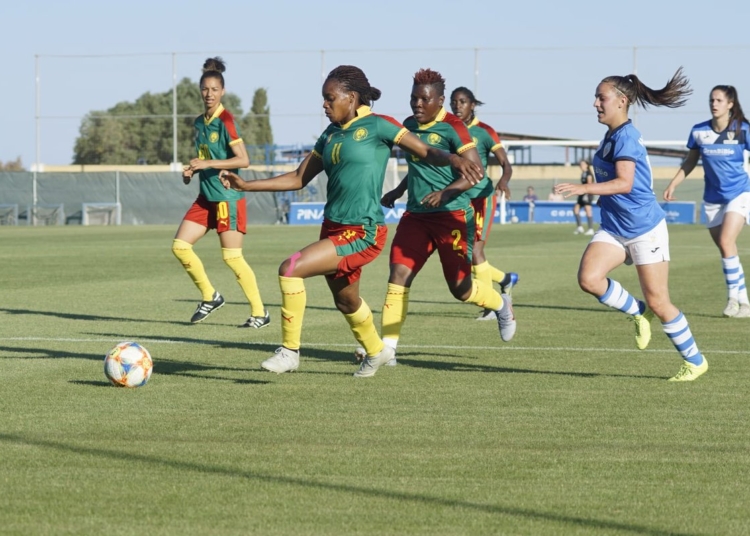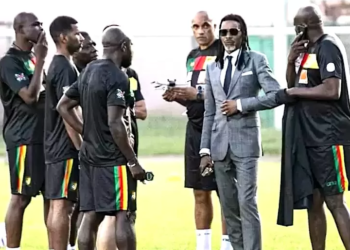The next few weeks could prove to be pivotal in determining how far and fast women’s and girls’ football in the world can continue to grow. On 6 June the Women’s World Cup will kick off in France – and the Lionesses, ranked forty-sixth in the world, are not among the favourites. Another qualification for the round of 16 would not only be of huge significance to the Lionesses but also to the future of the sport in Cameroon at every level – from grassroots to the professional game.
It would also almost certainly raise further the aspirations of the FA (FECAFOOT), which is ambitious for growth for the women’s game. At the core of this is one central aim: to create an awareness of the women’s game by instituting a professional championship at all category levels. But how far can the FA, supporters and enthusiasts of the women’s game really expect it to go? Are there insurmountable barriers to our acceptance of the female game – and should we even care?
To help start answering those questions, a bit of history may help.
First spotted in Rio de Janeiro as a circus feature in the 1930s, women’s football in Brazil was forbidden by a presidential decree signed by Getúlio Vargas in 1941 and that lasted until 1979, based on the reasoning that football was “incompatible with the conditions of the feminine nature”. So it was only in the 1980s that women’s football took off and started to spread.
One of the other big stumbling blocks on the road to growing the game is continued poor attendance at league matches in Cameroon and in many countries around the world.
Although FECAFOOT, as well as an army of enthused teachers, parents, coaches and volunteers up and down the country, is doing its level best to raise the profile of the game, there is still a long way to go.
« At times, we are forced to relocate matches or simply postpone them because we can’t afford to play on rocky pitches in this era. The way women’s football is structured in Cameroon isn’t reflective of the country’s reputation as a continental heavyweight. » — former Cameroon international Regine Mvoue.
« The Lionesses have a good coach in Alain Djeumfa, but things aren’t made easy for him. The women’s league didn’t kickoff properly and it’s difficult for him to scout for new players. We have to be pragmatic. I fear with such poor preparation we may have a poor output in France. » — Cameroon football coach Victorine Fomum.
This is surely inevitable when one of the biggest barriers to progress is a deeply entrenched attitude many still share – even if they don’t say it out loud. And that is that football is a boy’s game.
Reasons for progress
In June 2018 the French Federation (FFF) released the following figures: 169,312 affiliated women (125,412 players, 35,000 officials, 8,000 coaches and 900 referees. However, the number of affiliated women has increased significantly (+15%) since the men’s side won the World Cup in Russia. The target of the FFF was to reach 250,000 by the time this World Cup starts.
In Norway, one of the powerhouses of women’s football, the women’s budget this year is actually higher (14.8m Norwegian kroner (963m FCFA)) than the men’s (12.4m NOK (831m FCFA)) because it is a World Cup year. Interestingly – and impressively – the women earn as much as the men (6.8m NOK per year (456m FCFA)) after the men took a pay cut in 2017.
Last March, Juventus Women played for the first time at the club’s Allianz Stadium against second-placed Fiorentina in front of a crowd of 39,027. The previous record attendance for a women’s club match in Italy was set in 2008, when Bardolino and Frankfurt played in front of 14,000 spectators. Sky Sports in Italy has secured (non-exclusive) rights to broadcast the World Cup and Italian players are becoming increasingly popular with Italian football fans.
In Brazil, the top league now consists of 16 teams with all the men’s team obliged to have a women’s team if they are to keep their professional license. This led to some of the bigger clubs joining forces with women’s teams that already existed.
All you need to know about the FIFA’s Women World Cup France 2019
When: The tournament begins June 7, 2019, and ends July 7, 2019.
Where: Venues include Parc Olympique Lyonnais (Lyon), Parc des Princes (Paris), Allianz Riviera (Nice), Stade de la Mosson (Montpellier), Roazhon Park (Rennes), Stade Océane (Le Havre), Stade du Hainaut (Valenciennes), Stade Auguste-Delaune (Reims), Stade des Alpes (Grenoble).
Opening match: Host France opens the tournament against Korea on June 7, 2019.
How to watch: CRTV, the state broadcaster, has exclusive rights over the national territory
Here are the groups for all 24 countries in the Women’s World Cup:
Group A
- France
- South Korea
- Norway
- Nigeria
Group B
- Germany
- China
- Spain
- South Africa
Group C
- Australia
- Italy
- Brazil
- Jamaica
Group D
- England
- Scotland
- Argentina
- Japan
Group E
- Canada
- Cameroon
- New Zealand
- Netherlands
Group F
- United States
- Thailand
- Chile
- Sweden
Elume Raymond (Sports Analyst)













